
Psiloxylon mauritianum is a species of flowering plant, the sole species of the genus Psiloxylon. It is endemic to the Mascarene Islands in the Indian Ocean.

Amaryllis belladonna, the Jersey lily, belladonna-lily, naked-lady-lily, or March lily, is a plant species native to Cape Province in South Africa but widely cultivated as an ornamental. It is reportedly naturalized in many places: Corsica, Portugal, the Azores, Madeira, the Canary Islands, the Scilly Isles of Great Britain, the Democratic Republic of the Congo, Ascension Island, Australia, New Zealand, Mexico, Cuba, Haiti, the Dominican Republic, Chile, California, Texas, Louisiana, Mississippi, Michigan and the Juan Fernández Islands.
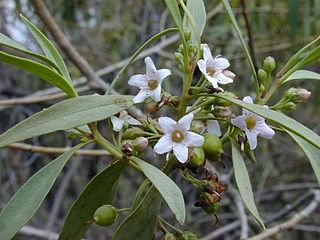
Myoporum is a genus of flowering plants in the figwort family, Scrophulariaceae. There are 30 species in the genus, eighteen of which are endemic to Australia although others are endemic to Pacific Islands, including New Zealand, and one is endemic to two Indian Ocean islands. They are shrubs or small trees with leaves that are arranged alternately and have white, occasionally pink flowers and a fruit that is a drupe.
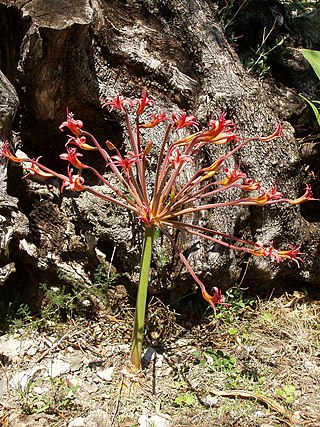
Brunsvigia is a genus of African flowering plants in the family Amaryllidaceae, subfamily Amaryllidoideae. It contains about 20 species native to southeastern and southern Africa from Tanzania to the Cape Provinces of South Africa.
The wildlife of Mauritius consists of its flora and fauna. Mauritius is located in the Indian Ocean to the east of Madagascar. Due to its isolation, it has a relatively low diversity of wildlife; however, a high proportion of these are endemic species occurring nowhere else in the world. Many of these are now threatened with extinction because of human activities including habitat destruction and the introduction of non-native species. Some have already become extinct, most famously the dodo which disappeared in the 17th century.

Boophone is a small genus of herbaceous, perennial and bulbous plants in the Amaryllis family It consists of two confirmed species distributed across South Africa to Kenya and Uganda. It is closely related to Crossyne, a genus whose species have prostrate leaves. They are drought tolerant but not cold-hardy, and are very poisonous to livestock.

Calostemma is a small genus of herbaceous, perennial and bulbous plants in the Amaryllis family, commonly known as Wilcannia Lily. It consists of three species endemic to Australia, where they are distributed in arid regions with summer precipitation.

Brithys crini, the amaryllis borer, crinum borer, lily borer or Kew arches, is a moth of the family Noctuidae. It is a garden pest in parts of its range, as their larvae damage the stems and leaves of lilies, especially lilies of the family Amaryllidaceae.
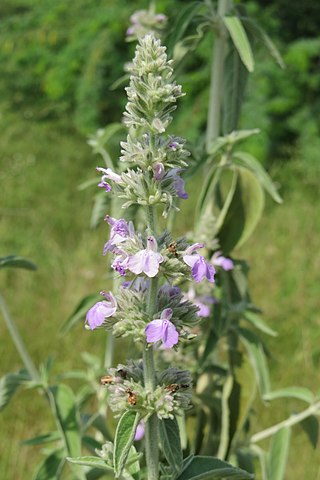
Anisomeles malabarica, more commonly known as the Malabar catmint, is a species of herbaceous shrub in the family Lamiaceae. It is native to tropical and subtropical regions of India, and Sri Lanka, but can also be found in Malaysia, Bangladesh, Myanmar, Bismarck Archipelago, Mauritius, Andaman Islands and Réunion.

Ammocharis nerinoides is a plant species endemic to Namibia, known from the Gobabis and Etoshapan Districts. It occurs in desert regions in river beds occasionally flooded with seasonal rainfall. It is also cultivated elsewhere for its showy flowers.

Dr. Bibi Ameenah Firdaus Gurib-FakimGCSK is a Mauritian politician and biodiversity scientist who served as the sixth president of Mauritius from 2015 to 2018. In December 2014, she was selected to be the presidential candidate of the Alliance Lepep. After Kailash Purryag resigned on 29 May 2015, both Prime Minister Sir Anerood Jugnauth and Leader of the Opposition Paul Berenger positively welcomed her nomination, which was unanimously approved in a vote in the National Assembly.
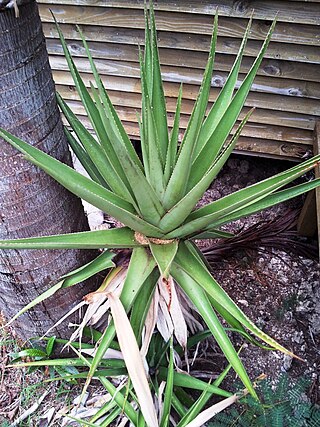
Aloe tormentorii is a species of Aloe endemic to the island of Mauritius, in the Indian Ocean.

Aloe purpurea is a species of Aloe endemic to the island of Mauritius, in the Indian Ocean, where it formerly occurred on dry rocky slopes and outcrops, the highland plateaus, and the forests of the west. It is part of a group of aloes which bear fleshy berries, and were therefore classed as a separate group, "Lomatophyllum". It is also one of only two Aloe species which naturally occur on Mauritius - both endemic and occurring nowhere else.

Aloe lomatophylloides is a unique species of Aloe endemic to the island of Rodrigues, in the Indian Ocean. It is part of a group of aloes which bear fleshy berries, and were therefore classed as a separate group, Aloe section Lomatophyllum.
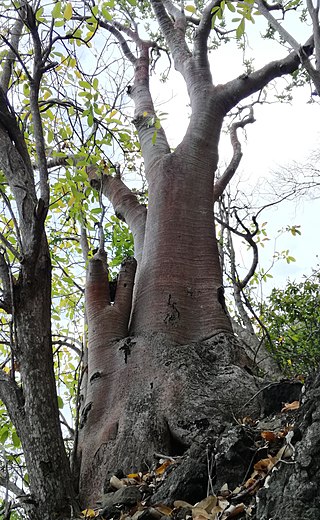
Cyphostemma mappia is a species of caudiciform succulent plant endemic to Mauritius. It is sometimes known as the "Mauritian baobab", though it is member of the grape family (Vitaceae) and unrelated to the true Baobabs of Africa.
Myoporum mauritianum is a flowering plant in the figwort family Scrophulariaceae and is endemic to a few volcanic islands in the Indian Ocean. It is a small, low-branched shrub with serrated leaves and small white flowers and usually grows on calcarenite within 20 metres (70 ft) of the sea.
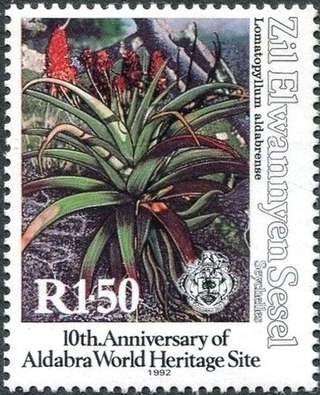
Aloe aldabrensis is a species of Aloe endemic to the islands of Aldabra in the Indian Ocean, where it can still be found in coastal scrub on limestone-based soil.
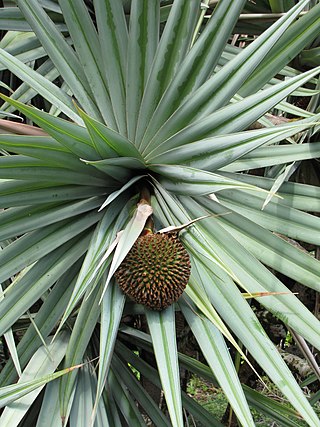
Pandanus vandermeeschii is a species of plant in the family Pandanaceae. It is endemic to the coastal areas of Mauritius.
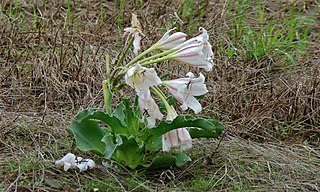
Crinum macowanii is a species of flowering plant in the Amaryllidaceae family. It is a deciduous bulbous plant species native to Africa that has been used in traditional medicine throughout southern Africa.

Pandanus rigidifolius is a species of plant in the family Pandanaceae, endemic to Mauritius.




















